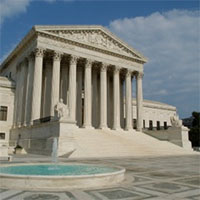New Top 5 LGBT Supreme Court Cases
With the release of the two opinions this week from the U.S. Supreme Court, the landscape has shifted, and these two decisions take their place among the top five most important decisions for LGBT people in the movement’s history:
1-Lawrence v. Texas
Year: 2003
Vote: 6 to 3
Ruling: A Texas law making it a crime for two adults of the same sex to have consensual sexual relations in private violates the Due Process Clause.
Impact: The ruling not only struck down the Texas law but those in eight other states. It also put a stop to the use of various other entities –employers, the military, family courts, and others—from using the existence of the laws to justify various other forms of discrimination against LGBT people. Many believe it is the decision that most paved the way for the success of much later litigation, including on marriage, to assert equal protection rights for LGBT people.
2-U.S. v. Windsor
Year: 2013
Vote: 5 to 4
Ruling: That the federal Defense of Marriage Act’s key provision, barring recognition of same-sex marriages in regards to federal benefits, violates the constitution’s guarantees to equal protection and due process.
Impact: Requires that the federal government provide married same-sex couples with the same benefits it provides to male-female married couples through more than 1,000 laws affecting an enormous range of matters, including taxes, Social Security, pensions, military family benefits, and immigration.
3-Bowers v. Hardwick
Year: 1986
Vote: 5 to 4
Ruling: A Georgia law making it a crime for two adults of the same sex to have consensual sexual relations in private was constitutionally permissible.
Impact: Politically and legally, Hardwick lashed out against an LGBT community that was growing dramatically, in part due to legal gains and in part due to a need to address the devastating effects of the HIV/AIDS epidemic. It was cited by hundreds of later decisions in courts across the nation to justify all various restrictions on the rights of LGBT people.
4-Romer v. Evans
Year: 1996
Vote: 6 to 3
Ruling: The voter-approved Amendment 2 to the Colorado constitution seeking to block any state or local jurisdictions from prohibiting discrimination based on sexual orientation violated the Equal Protection clause of the U.S. Constitution.
Impact: It overturned Colorado’s hostile law and put the brakes on a devastating trend of other states passing or attempting to pass similar initiatives. It also put governments on notice that they could not pass laws that disfavored LGBT people simply because a majority of voters dislike LGBT people.
5-Hollingsworth v. Perry
Year: 2013
Vote: 5 to 4
Ruling: The court ruled that private citizens do not have standing under federal rules of law to appeal a federal district court ruling striking down a law that the citizens wish to preserve. It was a ruling limited to a procedural matter–standing– but one which has enormous consequences in upholding, in this case, a district court ruling that California’s ban on same-sex marriage was unconstitutional.
Impact: By vacating a federal appeals court ruling in the Proposition 8 matter, the court left intact a district court ruling that now requires the state of California to issue marriage licenses to same-sex couples again. The addition of California, the most populous state in the country, to the marriage equality column (along with 12 other states and D.C.) increases the number of people living in marriage equality states to one-third of the nation’s population –almost double what it was before.



Leave a Reply